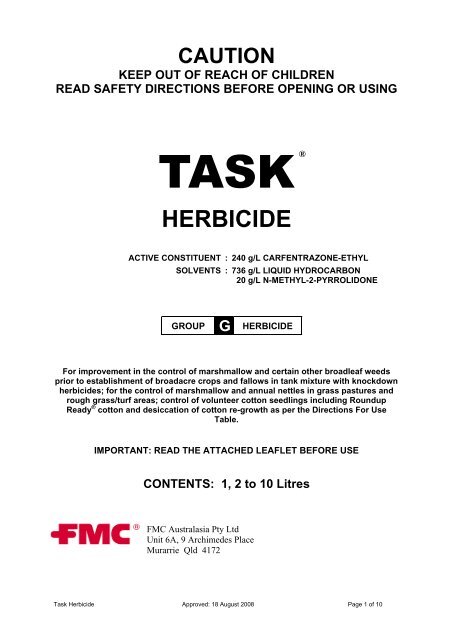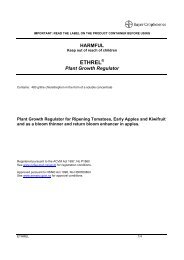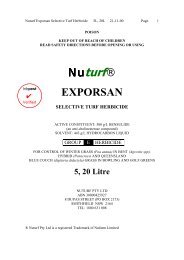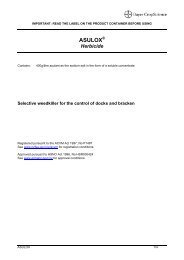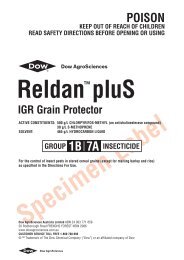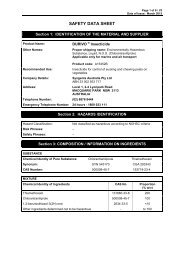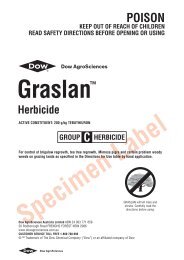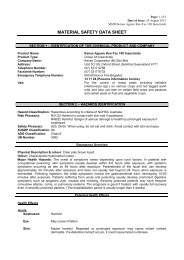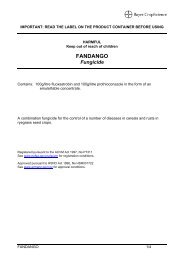HERBICIDE - Pest Genie
HERBICIDE - Pest Genie
HERBICIDE - Pest Genie
Create successful ePaper yourself
Turn your PDF publications into a flip-book with our unique Google optimized e-Paper software.
CAUTION<br />
KEEP OUT OF REACH OF CHILDREN<br />
READ SAFETY DIRECTIONS BEFORE OPENING OR USING<br />
TASK<br />
®<br />
<strong>HERBICIDE</strong><br />
ACTIVE CONSTITUENT : 240 g/L CARFENTRAZONE-ETHYL<br />
SOLVENTS : 736 g/L LIQUID HYDROCARBON<br />
20 g/L N-METHYL-2-PYRROLIDONE<br />
GROUP<br />
G <strong>HERBICIDE</strong><br />
For improvement in the control of marshmallow and certain other broadleaf weeds<br />
prior to establishment of broadacre crops and fallows in tank mixture with knockdown<br />
herbicides; for the control of marshmallow and annual nettles in grass pastures and<br />
rough grass/turf areas; control of volunteer cotton seedlings including Roundup<br />
Ready ® cotton and desiccation of cotton re-growth as per the Directions For Use<br />
Table.<br />
IMPORTANT: READ THE ATTACHED LEAFLET BEFORE USE<br />
CONTENTS: 1, 2 to 10 Litres<br />
FMC Australasia Pty Ltd<br />
Unit 6A, 9 Archimedes Place<br />
Murarrie Qld 4172<br />
Task Herbicide Approved: 18 August 2008 Page 1 of 10
STORAGE AND DISPOSAL<br />
Store in the closed, original container in a cool, well-ventilated area. Do not store for prolonged<br />
periods in direct sunlight.<br />
Triple or preferably pressure rinse containers before disposal. Add rinsings to spray tank. Do not<br />
dispose of undiluted chemicals on site. If recycling, replace cap and return clean containers to<br />
recycler or designated collection point. If not recycling, break, crush, or puncture and bury empty<br />
containers in a local authority landfill. If no landfill is available, bury the containers below 500 mm in a<br />
disposal pit specifically marked and set up for this purpose clear of waterways, desirable vegetation<br />
and tree roots. Empty containers and product should not be burnt.<br />
SAFETY DIRECTIONS<br />
Will irritate the eyes and skin. Avoid contact with eyes and skin. If product on skin, immediately wash<br />
area with soap and water. If product in eyes, wash it out immediately with water. Wash hands after<br />
use. When opening the container and preparing spray, wear cotton overalls buttoned to the neck and<br />
wrist and a washable hat, elbow-length PVC gloves and face shield or goggles. When using the<br />
prepared spray, wear cotton overalls buttoned to the neck and wrist (or equivalent clothing) and elbowlength<br />
PVC gloves. After each day’s use, wash gloves, face shield or goggles and contaminated<br />
clothing.<br />
FIRST AID<br />
If poisoning occurs, contact a doctor or Poisons Information Centre. Phone Australia 13 11 26. If<br />
swallowed, do NOT induce vomiting. Give a glass of water. If in eyes, wash out immediately with<br />
water.<br />
MATERIAL SAFETY DATA SHEET<br />
Additional information is listed in the Material Safety Data Sheet which is available from your supplier<br />
or the Nufarm website: www.nufarm.com.au<br />
Conditions of sale<br />
"Any provisions or rights under the Trade Practices Act 1974 or relevant state legislation which cannot be<br />
excluded by those statutes or by law are not intended to be excluded by these conditions of sale. Subject to<br />
the foregoing, all warranties, conditions, rights and remedies, expressed or implied under common law,<br />
statute or otherwise, in relation to the sale, supply, use or application of this product, are excluded.<br />
Nufarm Australia Limited and/or its affiliates ("Nufarm") shall not accept any liability whatsoever (including<br />
consequential loss), or howsoever arising (including negligence) for any damage, injury or death connected<br />
with the sale, supply, use or application of this product except for liability which cannot be excluded by<br />
statute."<br />
FMC and Task are Registered Trademarks of FMC Corporation, Philadelphia USA<br />
Roundup Ready is a Registered Trademark of Monsanto Technology LLC.<br />
In case of emergency: Phone 1800 033 498<br />
Ask for shift supervisor: Toll free 24 hours.<br />
Bar codes,<br />
drumMUSTER logo and<br />
labels codes to be<br />
inserted as appropriate<br />
APVMA Approval No: 62711/1L/0708<br />
62711/2-10L/0708<br />
BN:<br />
DOM:<br />
Task Herbicide Approved: 18 August 2008 Page 2 of 10
CAUTION<br />
KEEP OUT OF REACH OF CHILDREN<br />
READ SAFETY DIRECTIONS BEFORE OPENING OR USING<br />
TASK<br />
®<br />
<strong>HERBICIDE</strong><br />
ACTIVE CONSTITUENT : 240 g/L CARFENTRAZONE-ETHYL<br />
SOLVENTS : 736 g/L LIQUID HYDROCARBON<br />
20 g/L N-METHYL-2-PYRROLIDONE<br />
GROUP<br />
G <strong>HERBICIDE</strong><br />
For improvement in the control of marshmallow and certain other broadleaf weeds<br />
prior to establishment of broadacre crops and fallows in tank mixture with knockdown<br />
herbicides; for the control of marshmallow and annual nettles in grass pastures and<br />
rough grass/turf areas; control of volunteer cotton seedlings including Roundup<br />
Ready ® cotton and desiccation of cotton re-growth as per the Directions For Use<br />
Table.<br />
READ THIS LEAFLET BEFORE USING THIS PRODUCT<br />
Distributed by: Nufarm Austraila Ltd, 103-105 Pipe Road, Laverton North Vic 3026<br />
Task Herbicide Approved: 18 August 2008 Page 3 of 10
DIRECTIONS FOR USE<br />
Restraints<br />
DO NOT apply by aerial application except for cotton desiccation.<br />
Situation Weeds Controlled State Time of<br />
Application<br />
Prior to sowing<br />
winter and<br />
summer<br />
broadacre crops<br />
and starting a<br />
fallow.<br />
Australian Crassula/Stonecrop<br />
Crassula spp<br />
Capeweed<br />
Arctotheca calendula<br />
Chickweed<br />
Stellaria media<br />
Common storksbill (max. 4<br />
leaves)<br />
Erodium cicutarium<br />
Doublegee / Spiny emex / Three<br />
cornered jack<br />
Emex australis<br />
Marshmallow<br />
Malva parviflora<br />
Paterson’s curse<br />
Echium plantagineum<br />
Sub. clover<br />
Trifolium subterraneum<br />
Wild radish<br />
Raphanus raphanistrum<br />
Refer also to the product label for<br />
the knockdown herbicide used.<br />
If one of the above weeds is the<br />
dominant weed, and there is no<br />
specific rate for it in the<br />
knockdown herbicide’s label,<br />
consult the label’s generic annualweed<br />
rate-range.<br />
Select from within this range to<br />
suit the weed-stage, weed-density,<br />
conditions (etc) of your situation.<br />
All States<br />
Apply as a tank<br />
mix with<br />
Roundup<br />
PowerMAX,<br />
Roundup CT,<br />
Glyphosate CT,<br />
or Credit plus<br />
Bonus; Revolver<br />
or Nuquat.<br />
Rate<br />
25 - 75 mL/ha<br />
plus<br />
recommended<br />
label rates of<br />
knockdown<br />
herbicides<br />
Critical Comments<br />
Addition of TASK to knockdown herbicides will increase the speed<br />
at which treated broadleaved weeds in general develop visible<br />
symptoms (compared to results achieved with knockdown<br />
herbicides applied alone) and may improve final control of<br />
broadleaved weeds including certain hard-to-kill weeds,<br />
marshmallow in particular. The use of higher rates and full soil<br />
disturbance in cropping situations may improve control of<br />
marshmallow in particular.<br />
Use the lower rates on younger plants or plants growing under good<br />
conditions and the higher rates on older plants or plants growing<br />
under less optimum conditions.<br />
The lower rate may only provide suppression of capeweed, wild<br />
radish, common storksbill and doublegee under poor growing<br />
conditions. Common storksbill should be no larger than 4 leaf at<br />
spraying, recently germinated and not under stress – older or<br />
stressed plants may not be adequately controlled.<br />
Application to hardened weeds or drought stressed weeds<br />
especially under summer conditions may cause only localised injury<br />
to weed foliage which may not enhance final weed control. Mallow<br />
growing and sprayed in the summer is especially prone to drought<br />
stress and may either not show symptoms typical of TASK or may<br />
regrow following treatment although plants did not appear very<br />
stressed at application.<br />
Apply only as a tank mix with recommended rates of knockdown<br />
herbicides. Refer to the appropriate label for weed sizes and follow<br />
all label directions. Addition of Bonza at 0.5% may be beneficial<br />
when applying TASK with a glyphosate herbicide.<br />
To ensure uptake of TASK, DO NOT sow crops for at least 1 hour<br />
after application. Always refer to the appropriate companion<br />
product label in case a longer re-crop sowing period is required.<br />
Task Herbicide Draft: 18 August 2008 Page 4 of 10
Prior to sowing<br />
winter and<br />
summer<br />
broadacre crops<br />
and starting a<br />
fallow<br />
Cont.<br />
Volunteer cotton seedlings,<br />
including Roundup Ready varieties<br />
NSW, Qld,<br />
WA only<br />
Apply to<br />
seedlings at 2- 6<br />
leaf stage<br />
Roundup<br />
Ready cotton<br />
only :<br />
75 – 100 mL/ha<br />
plus Bonza 1%<br />
or<br />
Apply TASK in a minimum spray volume of 80 L/ha to ensure<br />
effective coverage. Use of lower spray volumes may reduce weed<br />
control. Cotton should be growing well at application; application to<br />
plants growing under heat and moisture stress may reduce the level<br />
of control.<br />
75 – 100 mL/ha<br />
plus Roundup<br />
PowerMAX,<br />
Roundup CT or<br />
Glyphosate CT<br />
plus Bonza<br />
0.5%<br />
To broaden the weed spectrum TASK may be tank mixed with the<br />
recommended rate of a knockdown herbicide (Roundup<br />
PowerMAX, Roundup CT, Glyphosate CT, Revolver or Nuquat).<br />
When using a tank mix with Roundup PowerMAX, Roundup CT or<br />
Glyphosate CT for control of Roundup Ready seedlings the higher<br />
rate range of TASK is required as well as Bonza at 0.5%.<br />
Grass pastures;<br />
Rough grass/<br />
turf areas<br />
Marshmallow<br />
Malva parviflora<br />
Annual (stinging) nettles<br />
Urtica urens<br />
All States<br />
Apply to<br />
seedlings at 2-<br />
10 leaf stage<br />
Conventional<br />
cotton only :<br />
50 - 75 mL/ha<br />
plus<br />
recommended<br />
rates of<br />
knockdown<br />
herbicides<br />
25 - 75 mL/ha<br />
plus Bonza<br />
0.5%<br />
25 - 75 mL/ha<br />
plus<br />
recommended<br />
rates of Amicide<br />
625 or Estercide<br />
Xtra 680<br />
When using a tank mix with Roundup PowerMAX, Roundup CT or<br />
Glyphosate CT for control of Conventional Cotton seedlings the<br />
addition of standard rates of a non-ionic surfactant such as<br />
Chemwet 1000 or 0.5% of an oil adjuvant such as Bonza will<br />
maximise control.<br />
Use the lower rates on younger plants or plants growing under good<br />
conditions and the higher rates on older plants or plants growing<br />
under less optimum conditions. These rates may only provide<br />
suppression of marshmallow.<br />
To improve the control of marshmallow TASK should be tank mixed<br />
with one of the following:<br />
570 mL/ha of Estercide Xtra 680<br />
750 mL/ha of Amicide 625 – activity of this mix will be improved with<br />
the addition of Bonza at 0.5%.<br />
Task Herbicide Draft: 18 August 2008 Page 5 of 10
Cotton Desiccation of regrowth Qld, NSW<br />
& WA only<br />
Apply to regrowth<br />
following<br />
defoliation<br />
80 – 100 mL/ha Use TASK to desiccate regrowth which occurs following the<br />
defoliation program.<br />
Apply with crop oil concentrates or blended oil/surfactant adjuvants<br />
as this may result in a greater reduction of green shoot.<br />
Use the higher rate of TASK when regrowth is vigorous or when<br />
there are more than 20 regrowth leaves of any size, per plant.<br />
Ensure that spray equipment is adjusted to provide thorough<br />
coverage of foliage to maximise product performance. Use a<br />
minimum of 100 L/ha for ground application and 30 L/ha for aerial<br />
application.<br />
NOT TO BE USED FOR ANY PURPOSE, OR IN ANY MANNER, CONTRARY TO THIS LABEL UNLESS AUTHORISED UNDER APPROPRIATE LEGISLATION.<br />
WITHHOLDING PERIOD:<br />
HARVEST: NOT REQUIRED FOR TASK <strong>HERBICIDE</strong> WHEN USED AS DIRECTED.<br />
HOWEVER, REFER ALSO TO THE WITHHOLDING PERIOD OF PRODUCT/S MIXED WITH TASK <strong>HERBICIDE</strong>.<br />
GRAZING: DO NOT GRAZE TREATED AREAS OR CUT FOR STOCKFOOD FOR 14 DAYS AFTER APPLICATION.<br />
COTTON PROCESSING:<br />
GRAZING/COTTON TRASH:<br />
DO NOT HARVEST FOR 1 DAY AFTER APPLICATION.<br />
DO NOT GRAZE TREATED AREAS OR FEED COTTON TRASH TO LIVESTOCK.<br />
EXPORT SLAUGHTER INTERVAL (ESI):<br />
An export slaughter interval is not required when used as directed.<br />
Task Herbicide Draft: 18 August 2008 Page 6 of 10
GENERAL INSTRUCTIONS<br />
TASK Herbicide is an emulsifiable concentrate formulation and is to be mixed with water and applied<br />
as per the labelled Directions for Use.<br />
TASK is a post-emergence herbicide to be added to knockdown herbicides to improve the control of<br />
certain broadleaf weeds including marshmallow prior to the establishment of fallows, winter and<br />
summer broadacre crops. TASK can be used alone with a suitable adjuvant for control of volunteer<br />
cotton seedlings including Roundup Ready cotton. It will also control marshmallow and stinging<br />
nettles in grass pastures and can be used to desiccate regrowth of cotton following defoliation.<br />
TASK is a fast acting contact herbicide and aids in control of weeds through a process of membrane<br />
disruption. The foliar uptake of TASK is rapid and plant desiccation can occur within 4 days of<br />
application. Application of TASK should target small actively growing weeds. Subsequent<br />
germinations will not be controlled.<br />
SYMPTOMS<br />
TASK is rapidly absorbed through the foliage of plants. Within a few hours following application, the<br />
foliage of susceptible weeds show signs of desiccation, and in subsequent days necrosis and death of<br />
the plant.<br />
Extremes in environmental conditions eg. temperature and moisture, soil conditions and cultural<br />
practices may affect the activity of TASK. Under warm moist conditions, herbicide symptoms may be<br />
accelerated. While under very dry conditions, the expression of herbicidal symptoms is delayed, and<br />
weeds hardened off by drought are less susceptible to TASK.<br />
COMPATIBILITY<br />
For most uses as per the Directions for Use, TASK should always be tank mixed with formulations of<br />
knockdown herbicides including Roundup PowerMAX, Roundup CT, Glyphosate CT and Credit plus<br />
Bonus; Revolver and Nuquat. TASK is also compatible with partner herbicides commonly used with<br />
knockdown herbicides including, Nu-trazine 900 DF, Flowable Nu-trazine, Kamba 500, Amicide 625,<br />
Estercide Xtra 680, Nugran, Rifle, Simazine 900 DF, Flowable Simazine, TriflurX and Triflur Xcel. This<br />
compatibility claim is restricted to a three-way mix of TASK with any one of the above partner<br />
herbicides plus a knockdown herbicide (provided the knockdown herbicide label includes a claim of<br />
compatibility with that partner herbicide). TASK is compatible with non ionic surfactants (wetting<br />
agents) such as Chemwet 1000 and with oil adjuvants such as Bonza.<br />
RESISTANT WEEDS WARNING GROUP G <strong>HERBICIDE</strong><br />
TASK Herbicide is a member of the Aryl triazoline group of herbicides. Its mode of action is through a<br />
process of membrane disruption, which is initiated by the inhibition of the enzyme protoporphyrinogen<br />
oxidase. This inhibition interferes with the chlorophyll biosynthetic pathway. For weed resistance<br />
management TASK is a Group G herbicide.<br />
Some naturally occurring weed biotypes resistant to TASK and other Group G herbicides may exist<br />
through normal genetic variability in any weed population. The resistant individuals can eventually<br />
dominate the weed population if these herbicides are used repeatedly. These resistant weeds will not<br />
be controlled by TASK or other Group G herbicides.<br />
Since the occurrence of resistant weeds is difficult to detect prior to use, Nufarm Austraila Ltd accepts<br />
no liability for any losses that may result from the failure of TASK to control resistant weeds.<br />
TIMING<br />
Pre-crop, Volunteer cotton and Marshmallow in grass pastures<br />
Application should be made to small, actively growing weeds less than 6 to 8 leaf in stage. As TASK is<br />
a contact herbicide, best control is achieved when weeds are exposed and are not shielded by other<br />
weeds and or stubble.<br />
Cotton<br />
If cotton re-growth occurs after the initial defoliation program, apply TASK to desiccate re-growth prior<br />
to harvest.<br />
MIXING<br />
Add half the required volume of water to spray tank and start agitation. Add any partner SC or WG<br />
herbicide next if it should be added before an EC or knockdown herbicide. Add the measured amount<br />
of TASK next, followed by the knockdown herbicide (if required). Add balance of water to tank and add<br />
any adjuvant or additive if recommended for use with the knockdown herbicide as suggested in the<br />
Task Herbicide Draft: 18 August 2008 Page 7 of 10
Critical Comments. Maintain good agitation at all times until spraying is completed. DO NOT store<br />
spray mixture overnight.<br />
APPLICATION<br />
DO NOT apply by aerial application except for cotton desiccation.<br />
Ground sprayers<br />
Pre-crop, Volunteer cotton and Marshmallow in grass pastures<br />
Apply TASK as a broadcast application using a conventional boom sprayer with either mechanical or<br />
by-pass agitation.<br />
Use single orifice flat fan nozzles such as Spraying Systems TeeJet 11001, 110015, 11002 or<br />
equivalent sizes from other manufacturers or Spraying Systems TwinJet twin flat spray tips TJ60-<br />
11002, TJ60-11003 or TJ60-11004 or equivalent sizes from other manufacturers. Do not use 110-03<br />
or bigger single orifice nozzles or TJ11006 or bigger twin orifice nozzles with TASK. Do not use<br />
floodjet, low drift or air induction nozzles, boomless jets or misters or controlled droplet application<br />
equipment.<br />
Spray equipment should be properly calibrated to ensure correct and uniform application. Use a spray<br />
volume of 50 to 150 litres per hectare (minimum 80 L/ha for volunteer cotton). Experience has shown<br />
that increasing spray volumes can improve weed control. Use the lowest pressure and boom height<br />
which provides uniform coverage. Use the higher volume if weed infestation is heavy and/or tall.<br />
The best application conditions are when soil is moist, weather fine and rain unlikely within one hour or<br />
as specified for the knockdown herbicide.<br />
Extremes in environmental conditions eg. temperature and moisture, soil conditions and/or cultural<br />
practices may affect the activity of TASK. Under warm moist conditions, herbicide symptoms may be<br />
accelerated. While under very dry conditions, the expression of herbicidal symptoms is delayed, and<br />
weeds hardened off by drought are less susceptible to TASK.<br />
Cotton<br />
When desiccating cotton regrowth, use sufficient water to obtain complete coverage of all leaves, ie. at<br />
least 100 litres of water per hectare. Good coverage should be obtained with three or more nozzles<br />
per row depending upon crop height and canopy density.<br />
Aerial Application (for Cotton Desiccation Only)<br />
Apply by fixed wing aircraft in a minimum of 30 L/ha water and ensure thorough coverage. Do not<br />
exaggerate swath width.<br />
SPRAYER CLEAN OUT - AFTER THE USE OF TASK<br />
Thoroughly clean all spray equipment using the following procedure when you have finished spraying<br />
highly active materials such as carfentrazone-ethyl.<br />
In addition to the following procedure, ensure proper equipment clean-out for any other products<br />
mixed with TASK Herbicide as specified on the other product labels.<br />
IMPORTANT:<br />
More complete cleaning can be achieved if the spray equipment is cleaned immediately<br />
following each use.<br />
Mix only as much herbicide spray solution as needed at a time.<br />
DO NOT store the sprayer for any extended period of time, especially over night, with TASK<br />
Herbicide spray solution remaining in the tank, spray lines, spray boom plumbing, spray<br />
nozzles or strainers.<br />
Preparation of the Cleaning Solution:<br />
Prepare a spray equipment cleaning solution by mixing an alkaline detergent eg “OMO” or “SPREE” at<br />
a rate of 100g for every 100L of clean water used.<br />
Upon completion of applying TASK and before spraying sensitive crops including canola, pulses<br />
such as faba beans, lentils, other legumes and cotton:<br />
1. Fill the spray tank with sufficient cleaning solution to allow the operation of the spray system<br />
for a minimum of 15 minutes to thoroughly flush hoses, spray boom and spray nozzles then<br />
fill the spray tank to capacity to ensure contact of the solution with all internal surfaces.<br />
Let the cleaning solution soak in tank, pump and spray lines overnight.<br />
Task Herbicide Draft: 18 August 2008 Page 8 of 10
2. Before further use of the sprayer, operate the spray system for 15 minutes, then completely<br />
drain the sprayer system. Rinse the tank with clean water and flush through the hoses, spray<br />
boom, and spray nozzles.<br />
3. If possible spray a pesticide requiring an oil adjuvant onto cereals as a further means of<br />
removing possible residues of TASK before spraying sensitive crops.<br />
4. Immediately prior to commencement of spraying a sensitive crop, purge the boom lines by<br />
operating the spray system onto a fence line or waste area for sufficient time to remove any<br />
solution that has been residing in the spray lines. This is also recommended for<br />
subsequent tank loads or if the sprayer has been left standing for a period of time<br />
containing spray solution.<br />
5. If storing equipment for more than 48 hours, preferred practice is to clean spray equipment as<br />
outlined above allowing to soak over night, drain and flush with fresh water and leave fresh<br />
water in the spray tank, hoses, and spray booms until next use. This water must be drained<br />
from the spray boom and lines and flushed out with clean water before beginning any<br />
application to a sensitive crop.<br />
Properly dispose of all cleaning solution and rinsate safely in accordance with Federal, State, and<br />
local regulations and guidelines.<br />
Do not apply sprayer cleaning solutions or rinsate to sensitive crops.<br />
Should small quantities of TASK remain in inadequately cleaned mixing, loading and/or spray<br />
equipment, they may be released during subsequent applications potentially causing effects to<br />
sensitive crops and other vegetation.<br />
The above method is only effective if the cleaning solution comes into contact with every<br />
surface or contact point that may contain even minute carfentrazone-ethyl residues.<br />
CROP PLANT BACK & ROTATION RECOMMENDATIONS<br />
TASK Herbicide does not provide residual activity, therefore no crop plant back or rotational<br />
restrictions apply. However, check the label of any product mixed with TASK Herbicide, to determine<br />
any plant back periods or restrictions on use.<br />
RE-ENTRY<br />
Do not allow entry into treated areas until the spray has dried, unless wearing cotton overalls buttoned<br />
to the neck and wrist (or equivalent clothing) and chemical resistant gloves. Clothing must be<br />
laundered after each day's use.<br />
PROTECTION OF CROPS, NATIVE AND OTHER NON-TARGET PLANTS<br />
DO NOT apply under weather conditions, or from spray equipment, which may cause spray drift onto<br />
nearby susceptible plants, adjacent crops, or pastures, or onto wetlands, waterbodies or<br />
watercourses.<br />
Do not apply to vines less than 2 years old or vines with green bark unless protected from the spray<br />
solution by a physical barrier.<br />
PROTECTION OF WILDLIFE, FISH, CRUSTACEANS AND ENVIRONMENT<br />
Highly toxic to algae and aquatic plants. DO NOT contaminate streams, rivers or waterways with<br />
TASK or used container.<br />
STORAGE AND DISPOSAL<br />
Store in the closed, original container in a cool, well-ventilated area. Do not store for prolonged<br />
periods in direct sunlight.<br />
Triple or preferably pressure rinse containers before disposal. Add rinsings to spray tank. Do not<br />
dispose of undiluted chemicals on site. If recycling, replace cap and return clean containers to<br />
recycler or designated collection point. If not recycling, break, crush, or puncture and bury empty<br />
containers in a local authority landfill. If no landfill is available, bury the containers below 500 mm in a<br />
disposal pit specifically marked and set up for this purpose clear of waterways, desirable vegetation<br />
and tree roots. Empty containers and product should not be burnt.<br />
SAFETY DIRECTIONS<br />
Will irritate the eyes and skin. Avoid contact with eyes and skin. If product on skin, immediately wash<br />
area with soap and water. If product in eyes, wash it out immediately with water. Wash hands after<br />
use. When opening the container and preparing spray, wear cotton overalls buttoned to the neck and<br />
wrist and a washable hat, elbow-length PVC gloves and face shield or goggles. When using the<br />
prepared spray, wear cotton overalls buttoned to the neck and wrist (or equivalent clothing) and<br />
Task Herbicide Draft: 18 August 2008 Page 9 of 10
elbow-length PVC gloves. After each day’s use, wash gloves, face shield or goggles and<br />
contaminated clothing.<br />
FIRST AID<br />
If poisoning occurs, contact a doctor or Poisons Information Centre. Phone Australia 13 11 26. If<br />
swallowed, do NOT induce vomiting. Give a glass of water. If in eyes, wash out immediately with<br />
water.<br />
MATERIAL SAFETY DATA SHEET<br />
Additional information is listed in the Material Safety Data Sheet which is available from your supplier<br />
or the Nufarm website: www.nufarm.com.au<br />
Conditions of sale<br />
"Any provisions or rights under the Trade Practices Act 1974 or relevant state legislation which cannot<br />
be excluded by those statutes or by law are not intended to be excluded by these conditions of sale.<br />
Subject to the foregoing, all warranties, conditions, rights and remedies, expressed or implied under<br />
common law, statute or otherwise, in relation to the sale, supply, use or application of this product, are<br />
excluded. Nufarm Australia Limited and/or its affiliates ("Nufarm") shall not accept any liability<br />
whatsoever (including consequential loss), or howsoever arising (including negligence) for any<br />
damage, injury or death connected with the sale, supply, use or application of this product except for<br />
liability which cannot be excluded by statute."<br />
In case of emergency: Phone (1800) 033 498.<br />
Ask for shift supervisor. Toll free 24 hours.<br />
FMC and Task are Registered Trademarks of FMC Corporation, Philadelphia USA.<br />
Amicide, Bonus, Bonza, Credit, Estercide, Kamba, Nuquat, Revolver, Rifle, TriflurX & Triflur Xcel are<br />
Registered Trademarks of Nufarm.<br />
Nugran, Roundup, Roundup Ready & Roundup PowerMAX are Registered Trademarks.<br />
Distributed by:<br />
Nufarm Australia Limited<br />
ACN 004 377 780<br />
103-105 Pipe Road<br />
Laverton North Victoria 3026<br />
Tel: (03) 9282 1000<br />
Fax: (03) 9282 1001<br />
APVMA Approval No.: 62711/0708<br />
Task Herbicide Draft: 18 August 2008 Page 10 of 10


